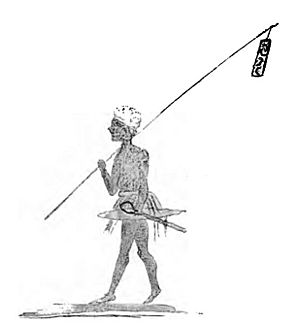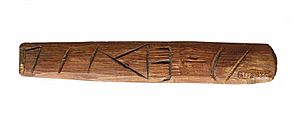Message stick facts for kids
A message stick is a special way of sending messages, used long ago by Aboriginal Australians. Messengers carried these sticks over long distances. They helped remember and prove the spoken message.
Message sticks were usually long pieces of wood with cool designs carved into them. They could be round or a bit flat. People all over Australia used them to share news between different Aboriginal groups and families. Experts started studying them in the 1880s. Anyone could see message sticks, even from far away. Sometimes, people confuse them with another important item called a tjurunga.
Contents
What Are Message Sticks Like?
Message sticks were usually solid pieces of wood. They were about 10 to 30 centimeters (4 to 12 inches) long. They had angular lines and dots carved into them. Some were round, like a cylinder, while others were a bit flattened.
People used them to send important news between different groups and families. They often invited other groups to special events. These events included corroborees (traditional dances), weddings, funerals, or even ball games. The marks on the stick would show who sent the message.
When a messenger entered another group's land, they would first make smoke signals. This let the other group know they were coming safely. The messenger would then be taken to the Aboriginal elders. There, they would deliver their message along with the stick.
In 1897, Robert Hamilton Mathews called them "talking-sticks" or "stick-letters."
Safe Passage for Messengers
The person carrying a message stick was given special protection. This was like a kind of diplomatic immunity. It meant they could travel safely into another group's area without being harmed.
Stories from History
Many people have written about message sticks. They show how important these sticks were.
Alfred Howitt's Account
In 1889, an expert named Alfred Howitt wrote about the Wurundjeri people. They lived near what is now Melbourne. He explained how a message stick was made:
- The oldest man (Headman) would make the stick.
- He would pass it to the next oldest man.
- This man would check it, add more marks if needed, and give instructions.
- The stick would go around to all the old men present.
- Finally, it was given to the messenger, who also got the spoken message.
- If the message was about time or how many camps to stop at, they had a special way to show that.
Jeannie Gunn's Story
Jeannie Gunn wrote about life in the Northern Territory in 1902. She described a "yabber-stick" (message stick):
- A man named 'Goggle-Eye' showed her a small stick with notches.
- He said it was a "blackfellow's letter-stick."
- It was round, not flat like most letters.
- It was an invitation to a corroboree.
- The notches explained what kind of corroboree it was.
- It also said the event would be held at Duck Creek.
- There was other news marked on it too.
Donald Thomson and Diplomacy
In 1935, Donald Thomson traveled to Arnhem Land. He wrote about a leader named Wonggu. Wonggu sent a message stick to his sons, who were in prison. The stick showed that he wanted a truce, or a peaceful agreement. The carvings on the stick showed people sitting together. Wonggu was in the middle, keeping the peace. This shows how message sticks became important tools for peace talks, especially in Northern Australia.
See also
- Devil's Pool, Australia
- Koori Mail
- National Indigenous Times Australia's largest circulating Indigenous affairs newspaper
- Australian Aboriginal artefacts



